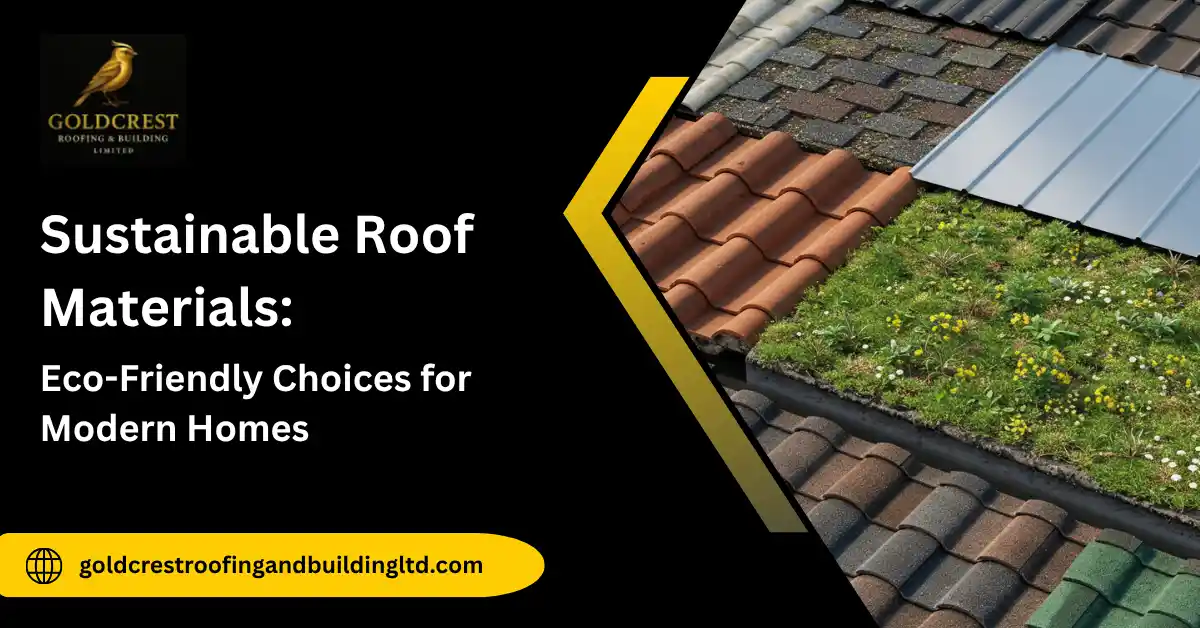Seeking sustainable roof materials that are eco-friendly, durable, and aesthetically pleasing? Choosing the right roof materials is more than a design decision; it impacts energy efficiency, comfort, and your home’s environmental footprint. Modern sustainable roofing materials UK offer a variety of options that combine longevity, performance, and aesthetics, helping you create a home that’s both responsible and comfortable.
By selecting eco-friendly roofing materials, you’re not only protecting the planet but also creating a safer, healthier, and more comfortable home for your family. From reflecting heat to improving insulation, the right materials make your home energy-efficient, lower bills, and more resilient to weather changes. Investing in eco roof materials is a long-term choice that benefits both your home and the environment.
What Are Sustainable Roof Materials and Why Are They Important?
Sustainable roofing materials are eco-conscious options made from renewable, recycled, or naturally abundant resources. They reduce environmental impact, last longer than conventional roofing, and help regulate indoor temperatures naturally.
Beyond energy efficiency, these materials promote a healthier home environment by reducing exposure to harmful chemicals often found in conventional roofs. They also improve comfort by maintaining consistent indoor temperatures and reducing noise. Additionally, they also contribute to long-term savings by lowering energy bills and minimising maintenance needs. Choosing eco roofing materials isn’t just good for the planet; it also adds value, efficiency, and comfort to your home.
Types of Sustainable Roof Materials
Exploring the right sustainable roof materials helps you create a home that is energy-efficient, durable, and environmentally responsible. Here are the top eco-friendly options for modern homes:
1. Clay and Concrete Tiles
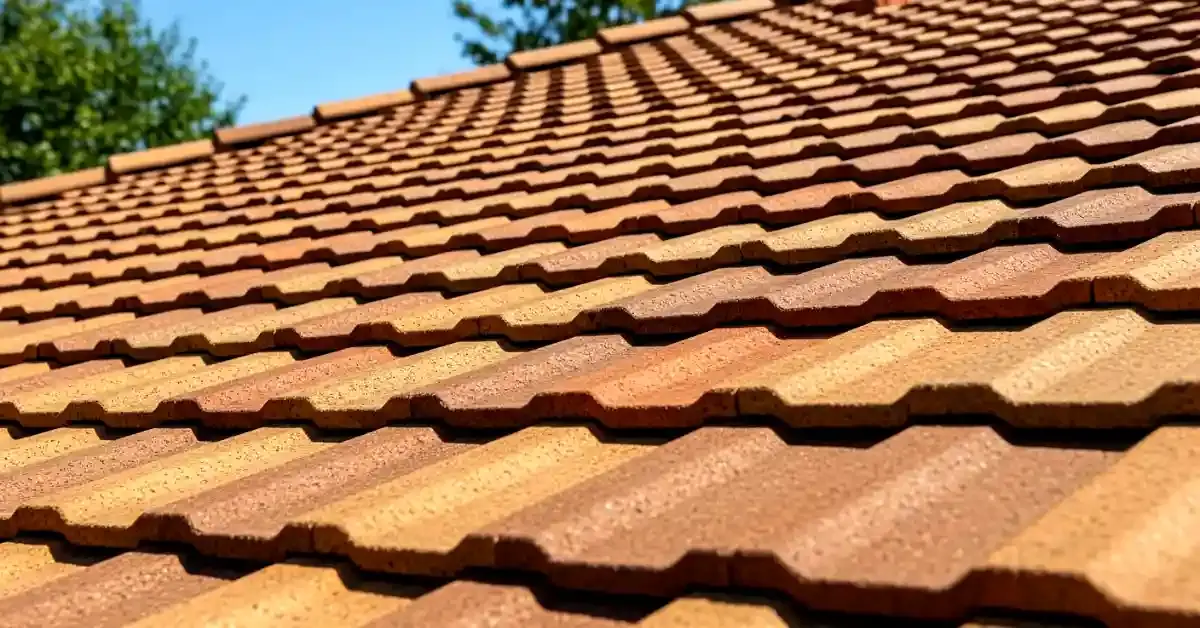
Clay and concrete tiles have been used for centuries and remain a top sustainable roofing material due to their natural composition and exceptional durability. Made from earthen materials, they are inherently green and age gracefully while performing consistently.
Benefits:
- Longevity: Can last over a century, reducing waste and replacement costs for a truly long-term solution. Their long life means fewer roof replacements and less environmental impact.
- Thermal Insulation: Helps regulate indoor temperatures, keeping homes cooler in hot climates and reducing energy consumption. This reduces reliance on air conditioning and lowers bills.
- Fire Resistance: Non-combustible materials offer excellent protection against fire, providing an added layer of safety for your home.
- Natural and Recyclable: Derived from natural resources and can be recycled at the end of their lifespan, minimising environmental impact.
2. Metal Roofing
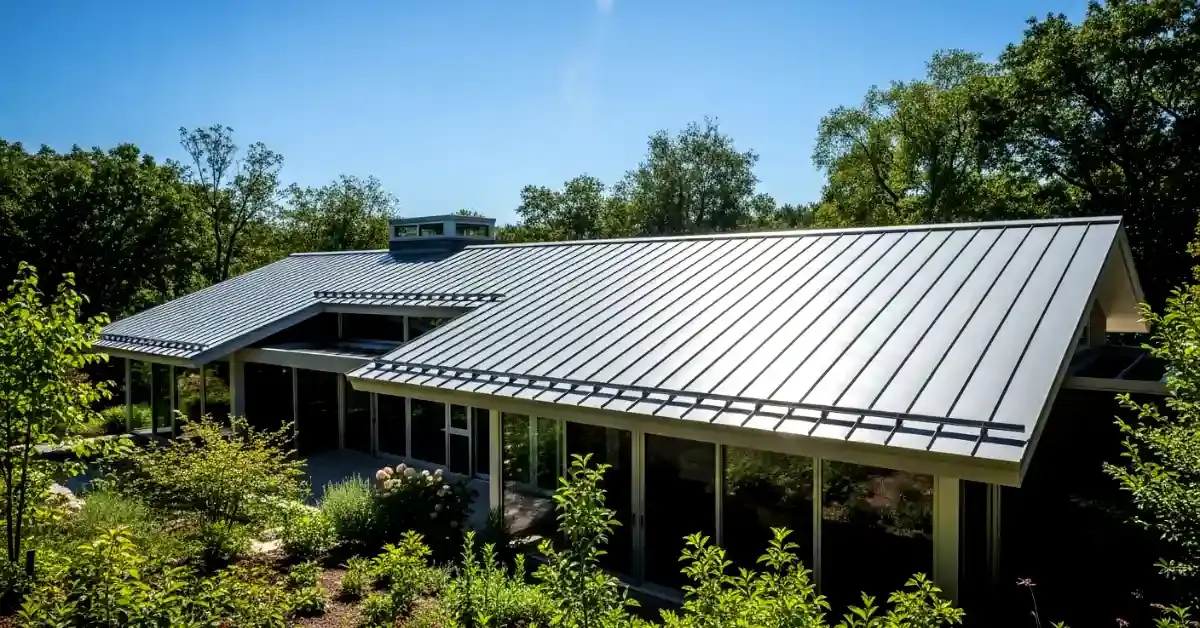
Metal roofs, made from recycled steel or aluminium, are lightweight, durable, and highly recyclable. Modern coatings improve energy efficiency by reflecting sunlight and reducing heat absorption, making them ideal eco roofing materials.
Benefits:
- Longevity: Can last 50+ years with minimal maintenance, reducing overall roof waste.
- Energy Efficiency: Reflective coatings lower cooling costs in the summer while insulating in the winter, helping to maintain a consistent indoor climate.
- Low Maintenance: Resistant to pests, rot, and severe weather conditions, making it a hassle-free option.
- Recyclable: Most metal roofs are made from recycled materials and are fully recyclable at the end of their life, making them an environmentally responsible choice.
3. Green Roofs
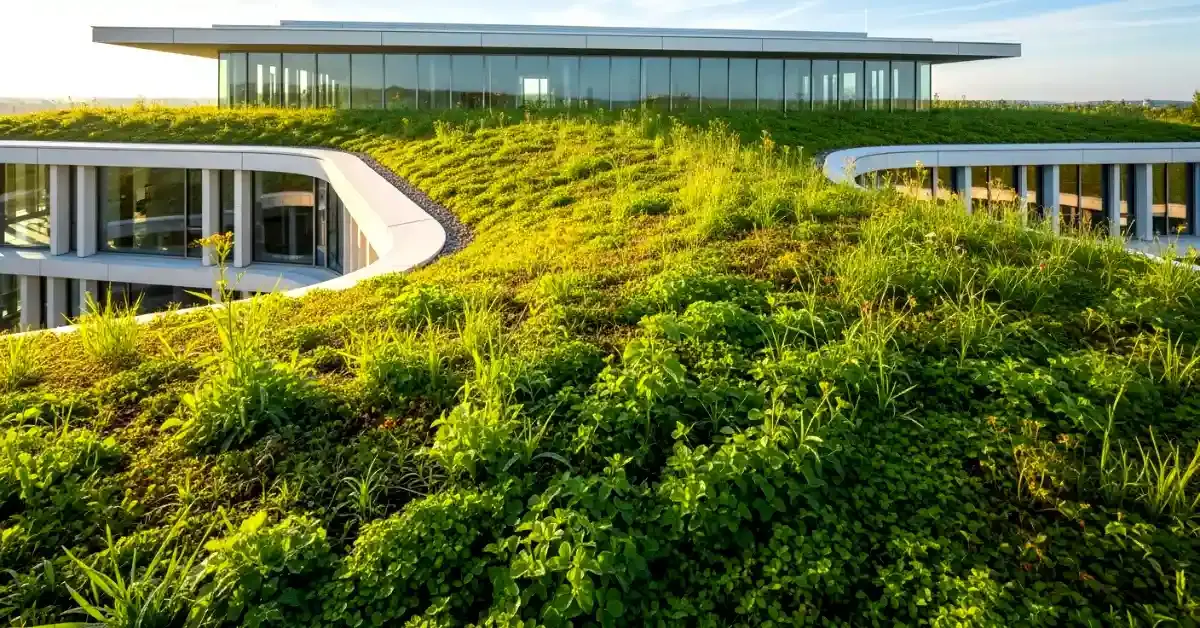
Green or living roofs feature vegetation layers that absorb rainwater, reduce heat, and improve air quality. They are highly effective, sustainable roofing materials for urban homes or areas prone to heat islands.
Benefits:
- Energy Savings: Plants provide natural insulation, lowering heating and cooling costs.
- Environmental Impact: Reduce stormwater runoff and improve urban biodiversity, supporting a healthier ecosystem.
- Air Quality: Vegetation absorbs pollutants and CO₂, contributing to cleaner air around your home.
- Noise Reduction: Natural layers act as a buffer, making homes quieter and more peaceful.
4. Cool Roofs
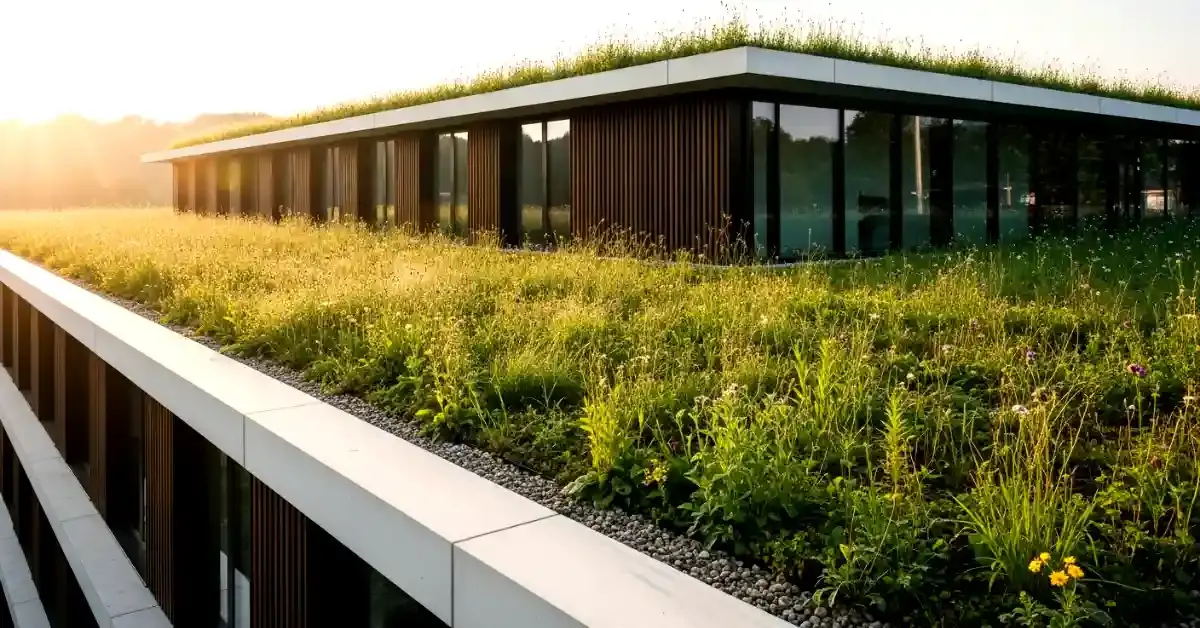
Cool roofs use reflective coatings or light-coloured materials to deflect sunlight and minimise heat absorption. This eco roofing material is ideal for warmer climates and contributes to energy savings.
Benefits:
- Reduced Cooling Costs: Reflects heat and keeps indoor spaces cooler, reducing reliance on air conditioning.
- Durable: Coatings protect the underlying roof from UV damage, extending the lifespan of your roof.
- Environmentally Friendly: Lower energy consumption reduces carbon footprint.
- Comfortable Indoor Climate: Helps maintain more consistent indoor temperatures year-round.
5. Recycled Shingles
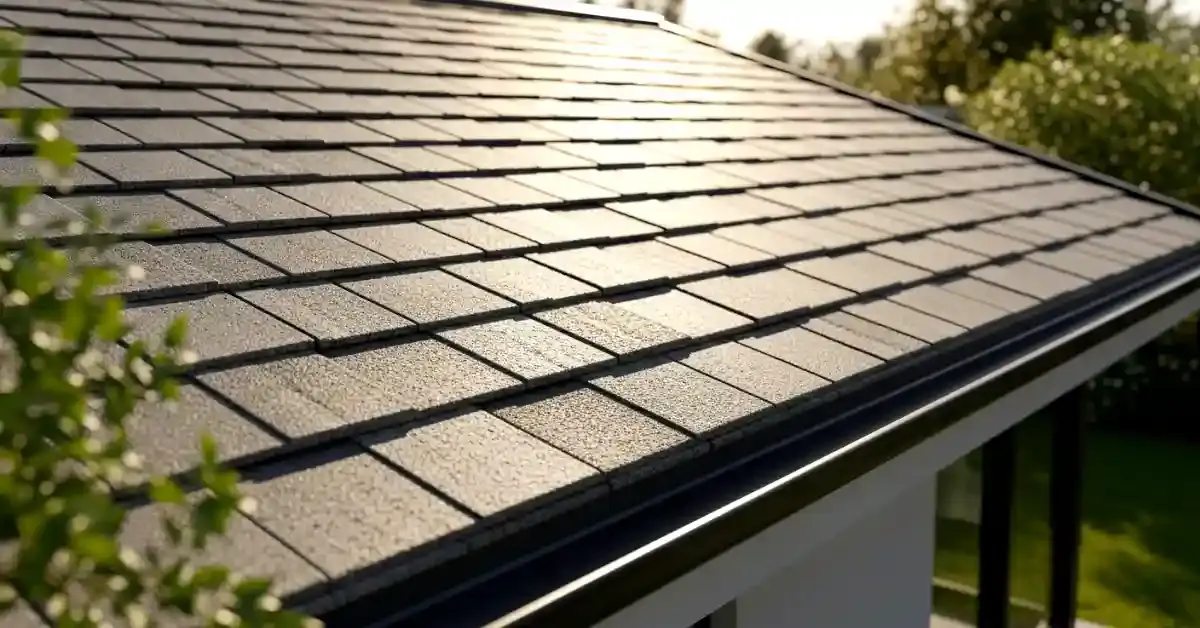
Shingles made from recycled materials, such as rubber or plastics, provide a sustainable alternative to traditional asphalt. They offer durability, flexibility, and a reduced environmental footprint.
Benefits:
- Waste Reduction: Repurposes materials that would otherwise be sent to landfills, thereby reducing the environmental burden.
- Durable: Resistant to cracking, wind, and UV damage, keeping its longevity.
- Low Maintenance: Easy to clean and maintain over the decades.
- Energy Savings: Can be combined with reflective coatings for added efficiency.
If you’re planning to upgrade your home with eco-friendly roofing, GoldCrest Roofing & Building Ltd is a leading roofing company in Lewisham that provides expert installation and sustainable roofing solutions tailored to your needs.
Factors to Consider When Choosing Sustainable Roofing Materials
- Climate Compatibility: Some eco-friendly roofing materials reflect heat in summer and insulate in colder months, providing year-round comfort and energy efficiency. Choosing materials suited to your local weather protects your investment and keeps your home comfortable in every season.
- Durability: Long-lasting roof materials reduce waste and prevent the need for frequent replacements. Durable options withstand harsh weather, protecting your home and maintaining roof performance.
- Budget: High-quality eco roof materials may have higher upfront costs, but they provide long-term energy and maintenance savings, preventing expensive repairs later.
- Aesthetics: Selecting sustainable roof materials that complement your home enhances curb appeal and adds property value while performing efficiently, resulting in a visually pleasing and functional roof.
Installation and Maintenance Tips
Proper installation is key to sustainable roofing materials. Hiring experienced professionals guarantees the correct layering, sealing, and placement of membranes, coatings, or vegetation layers. Regular inspections for debris, damage, or wear, along with trimming plants on green roofs and cleaning reflective surfaces on cool roofs, help maintain performance. Following these tips makes your sustainable roof deliver energy savings, comfort, and durability for decades.
Costs of Sustainable Roofing Materials
Sustainable roof materials vary in price depending on the type and installation, but all offer strong long-term value:
- Clay & Concrete Tiles: £70–£120 per m² installed
- Metal Roofing: £90–£150 per m² installed
- Green Roofs: £80–£250 per m² installed
- Cool Roofs: £40–£80 per m² installed
- Recycled Shingles: £80–£130 per m² installed
Though upfront costs are higher, these eco-roof materials reduce energy bills, last longer, and add value to your home.
Conclusion
Selecting sustainable roof materials is an investment in comfort, savings, and environmental responsibility. Eco-friendly roof materials lower energy bills, protect your home from harsh weather, and enhance property value while contributing to a greener planet. For the best outcome, hire trusted roofers who understand local home conditions, weather patterns, and the installation nuances of eco roofing materials. With the proper support, your sustainable roofing project will deliver long-lasting performance, comfort, and peace of mind for years to come.
FAQs
What is the alternative to a green roof?
Alternatives include cool roofs, metal roofing, or recycled shingles, all of which provide energy efficiency and reduced environmental impact, without the need for vegetation.
How to make a roof breathable?
Proper ventilation, breathable membranes, and correct installation prevent moisture buildup, keeping your roof durable and healthy.
How to insulate a roof without ventilation?
Specialised insulation methods like spray foam or rigid boards can be used, but careful installation is required to avoid moisture problems.
Are membrane roofs good?
Yes, modern membrane roofs are durable, water-resistant, and compatible with sustainable options such as cool roofs or green roofs.

